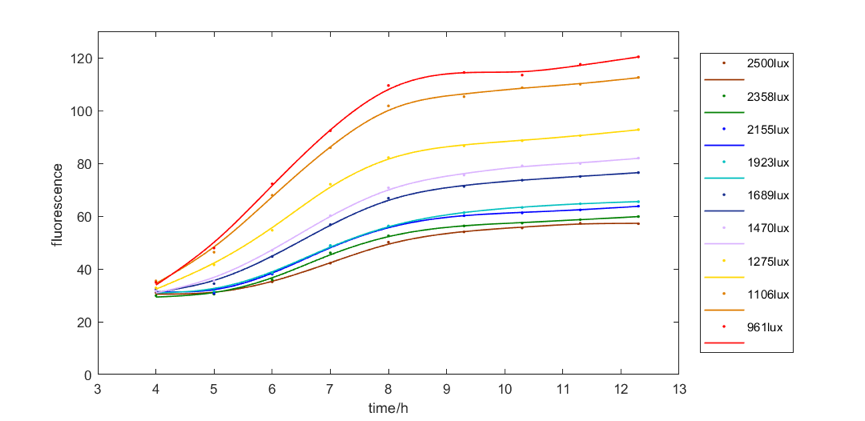Difference between revisions of "Part:BBa K2598027"
| Line 29: | Line 29: | ||
We explored the relationship between fluorescent intensity and illumination intensity, which affects the shade of the color. | We explored the relationship between fluorescent intensity and illumination intensity, which affects the shade of the color. | ||
| − | <b>Figure | + | <b>Figure 3</b> shows the red fluorescent intensity of E. coli under light of 620-630nm wavelength with different illumination intensity. We found when illuminated under around 961lux light, we can get the most red fluorescence. We also explore the relationship between green and blue fluorescent intensity of E. coli under light of 515-530nm wavelength and 460-470nm wavelength respectively and illumination intensity. The results are similar, that is, moderate intensity of light is most favorable for E. coli to express fluorescence. |
| − | <div>[[File:T—UCAS-China—RRR2018.png|700px|thumb|center|<b>Figure | + | <div>[[File:T—UCAS-China—RRR2018.png|700px|thumb|center|<b>Figure 3:</b>The relationship between the red fluorescent intensity of E. coli under light of 620-630nm wavelength and illumination intensity]]</div> |
Revision as of 06:20, 16 October 2018
bFMO(bacterial flavin-containing monooxygenase)
This is a bacterial flavin-containing monooxygenase(bFMO). It can catalyse tryptophan and render it blue. This part van be used as a reporter gene and, in our project, paint.
Sequence and Features
- 10COMPATIBLE WITH RFC[10]
- 12COMPATIBLE WITH RFC[12]
- 21COMPATIBLE WITH RFC[21]
- 23COMPATIBLE WITH RFC[23]
- 25INCOMPATIBLE WITH RFC[25]Illegal AgeI site found at 157
Illegal AgeI site found at 180
Illegal AgeI site found at 484
Illegal AgeI site found at 814 - 1000COMPATIBLE WITH RFC[1000]
Characterization
Figure 1 shows results of gel electrophoresis of various parts after PCR with primer VF2\VR. The distance between primer binding sites and both ends of the parts are approximately 150 bp, thus rendering the product about 300 bp longer. The picture is edited to show a more compact photo.
Figure 2 shows colors produced by enzymes that can combine with substrate in the medium. We changed the output genes of our light control system to genes encoding three kinds of enzymes, including gusA(BBa_K330002), lacZ(BBa_I732005) and bFMO(BBa_K2598027) that can combine with substrate in the medium to produce red, green and blue color respectively.
We explored the relationship between fluorescent intensity and illumination intensity, which affects the shade of the color.
Figure 3 shows the red fluorescent intensity of E. coli under light of 620-630nm wavelength with different illumination intensity. We found when illuminated under around 961lux light, we can get the most red fluorescence. We also explore the relationship between green and blue fluorescent intensity of E. coli under light of 515-530nm wavelength and 460-470nm wavelength respectively and illumination intensity. The results are similar, that is, moderate intensity of light is most favorable for E. coli to express fluorescence.


